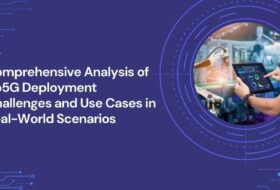SCG Failure 5G NR
-
RLF is declared separately for the MCG and for the SCG
-
If radio link failure is detected for MCG, the UE initiates the RRC connection re-establishment procedure
The following SCG failure cases are supported:
- SCG RLF
- SN change failure
- For EN-DC, NGEN-DC, and NR-DC, SCG configuration failure (only for messages on SRB3)
- For EN-DC, NGEN-DC, and NR-DC, SCG RRC integrity check failure (on SRB3).
- Upon SCG failure the UE suspends SCG transmissions for all radio bearers and reports the SCG Failure Information to the MN, instead of triggering re-establishment.
- In all SCG failure cases, the UE maintains the current measurement configurations from both the MN and the SN and the UE continues measurements based on the configuration from the MN and the SN if possible. The SN measurements configured to be routed via the MN will continue to be reported after the SCG failure
- The UE includes in the SCG Failure Information message the measurement results available according to the current measurement configuration of both the MN and the SN. The MN handles the SCG Failure Information message and may decide to keep, change, or release the SN/SCG. In all the cases, the measurement results according to the SN configuration and the SCG failure type may be forwarded to the old SN and/or to the new SN.
SCG failure information

-
The purpose of this procedure is to inform E-UTRAN or NR MN about an SCG failure the UE has experienced i.e.
-
SCG radio link failure, failure of SCG reconfiguration with sync, SCG configuration failure for RRC message on SRB3 and SCG integrity check failure
-
If the RLF happens on the UE’s SCG, a so-called SCG-RLF is declared by the UE. Since the UE’s MCG, where its RRC connection is terminated, is still operational, the consequences are less severe as there is no need to perform an RRC Reestablishment procedure.
How we can identify SCGFailureInformation from 3GPP specs
SCGFailureInformation
The SCGFailureInformation message is used to provide information regarding NR SCG failures detected by the UE.
Signaling radio bearer: SRB1
RLC-SAP: AM
Logical channel: DCCH
Direction: UE to Network
SCGFailureInformation ::= SEQUENCE {
criticalExtensions CHOICE {
scgFailureInformation SCGFailureInformation-IEs,
criticalExtensionsFuture SEQUENCE {}
}
}
SCGFailureInformation-IEs ::= SEQUENCE {
failureReportSCG FailureReportSCG OPTIONAL,
nonCriticalExtension SCGFailureInformation-v1590-IEs OPTIONAL
}
SCGFailureInformation-v1590-IEs ::= SEQUENCE {
lateNonCriticalExtension OCTET STRING OPTIONAL,
nonCriticalExtension SEQUENCE {} OPTIONAL
}
FailureReportSCG ::= SEQUENCE {
failureType ENUMERATED {
t310-Expiry, randomAccessProblem,
rlc-MaxNumRetx,
synchReconfigFailureSCG, scg-ReconfigFailure,
srb3-IntegrityFailure, other-r16, spare1},
measResultFreqList MeasResultFreqList OPTIONAL,
measResultSCG-Failure OCTET STRING (CONTAINING MeasResultSCG-Failure) OPTIONAL,
…,
[[
locationInfo-r16 LocationInfo-r16 OPTIONAL,
failureType-v1610 ENUMERATED {scg-lbtFailure-r16, beamFailureRecoveryFailure-r16, t312-Expiry-r16, bh-RLF-r16,
spare4, spare3, spare2, spare1} OPTIONAL
]]
TYPE OF SCG Failure Reason
- t310-Expiry
- synchReconfigFailure-SCG
- random access problem
- rlc-MaxNumRetx
- srb3-IntegrityFailure
- scg-reconfigFailure
- The UE suspends SCG transmission for all Signaling Radio Bearers (SRBs) and DRBs and resets its MAC entity in SCG.
- Afterward, the UE sends SCGFailureInformation message on its primary leg, i.e. to its Master Node. Note that in case of UE operating in EN-DC mode, the SCGFailureInformation message will be sent to an eNB, i.e. to E-UTRAN. The contents of the message indicate:
a. Failure type, i.e. whether the SCG failure occurred due to physical layer problems, random access issues, or RLC failure.
b. Radio resource management (RRM) measurements were obtained by the UE up to the moment of failure occurrence for the cells which were configured as UE’s serving cells in SCG as well as its neighboring cells. - The SCGFailureInformation may be used by the UE’s Master Node to facilitate subsequent SCG configuration. The Master Node may alternatively decide not to add an SCG for the UE
SCG failure information procedure triggered upon SCG RLF
SCGFailureInformationNR
| failureType-r15 | Any allowed value | t310-Expiry, OR randomAccessProblem, OR rlc-MaxNumRetx, OR synchReconfigFailureSCG, OR scg-reconfigFailure, OR srb3-IntegrityFailure |
| Timer | start | stop | expiry |
|---|---|---|---|
| t304 | Upon reception of RRCReconfiguration message including reconfigurationWithSync | Upon successful completion of random access on the corresponding SpCell For T304 of SCG, upon SCG release | For T304 of MCG, in case of the handover from NR or intra-NR handover, initiate the RRC reestablishment procedure; In case of handover to NR, perform the actions defined in the specifications applicable for the source RAT. For T304 of SCG, inform network about the reconfiguration with sync failure by initiating the SCG failure information procedure as specified in 5.7.3. |
| t310 | Upon detecting physical layer problems for the SpCell i.e. upon receiving N310 consecutive out-ofsync indications from lower layers. | Upon receiving N311 consecutive in-sync indications from lower layers for the SpCell, upon receiving RRCReconfiguration with reconfigurationWithSync for that cell group, and upon initiating the connection re-establishment procedure. Upon SCG release, if the T310 is kept in SCG. | If the T310 is kept in MCG: If AS security is not activated: go to RRC_IDLE else: initiate the connection re-establishment procedure. If the T310 is kept in SCG, Inform E-UTRAN/NR about the SCG radio link failure by initiating the SCG failure information procedure as specified in 5.7.3. |
How to improve such failure in the network.
RLF-TimersAndConstants (the IE RLF-TimersAndConstants is used to configure UE specific timers and constants)
RLF-TimersAndConstants ::= SEQUENCE {
t310 ENUMERATED {ms0, ms50, ms100, ms200, ms500, ms1000, ms2000, ms4000, ms6000}, change the timer value depend upon condition of network, Start from o to 6000ms
n310 ENUMERATED {n1, n2, n3, n4, n6, n8, n10, n20},
n311 ENUMERATED {n1, n2, n3, n4, n5, n6, n8, n10},
…,
[[
t311 ENUMERATED {ms1000, ms3000, ms5000, ms10000, ms15000, ms20000, ms30000}
]]
}
RLC-Config
The IE RLC-Config is used to specify the RLC configuration of SRBs and DRBs.
T-PollRetransmit ::= ENUMERATED {ms5, ms10, ms15, ms20, ms25, ms30, ms35,ms40, ms45, ms50, ms55, ms60, ms65, ms70,ms75, ms80, ms85, ms90, ms95, ms100, ms105,
ms110, ms115, ms120, ms125, ms130, ms135, ms140, ms145, ms150, ms155, ms160, ms165, ms170, ms175, ms180, ms185, ms190, ms195,
ms200, ms205, ms210, ms215, ms220, ms225, ms230, ms235, ms240, ms245, ms250, ms300, ms350, ms400, ms450, ms500, ms800, ms1000,
ms2000, ms4000, spare5, spare4, spare3, spare2, spare1}
By changing T-Pollretransmit value, this will help the scg failure rate, In the LTE older release version,the maximum value was 500 ms , but now its increased up to 400 ms, high value
will improve the scg failure rate.
t-PollRetransmit T-PollRetransmit,
pollPDU PollPDU,
pollByte PollByte,
maxRetxThreshold ENUMERATED { t1, t2, t3, t4, t6, t8, t16, t32 } Maximum number of retransmission, if it is t32 , it means 32 retransmission
a higher value will improve the drop rate but it would affect throughput
}
DL-AM-RLC ::= SEQUENCE {
sn-FieldLength SN-FieldLengthAM OPTIONAL, — Cond Reestab
t-Reassembly T-Reassembly,
t-StatusProhibit T-StatusProhibit
- srb3-IntegrityFailure
UE initiates transmission of the SCGFailureInformationNR message due to SRB3 integrity check failure
- scg-reconfigFailure
UE initiates the transmission of the SCGFailureInformationNR message due to the Reconfiguration failure of NR RRC reconfiguration message.
During the SCG failure, UE also reports the available measurement result under I(measResultFreqListNR-r15 and measResultSCG

Knowledge of eMBB, URLCC, MMTC.
5G RAN ARCHITECTURE, NR NSA mobility, Massive Mimo, Beamforming, 5G Frame structure, Ultra lean design, 5G QOS compare with LTE, Ericsson & Huawei RAN system for 5G. 5G planning Knowledge.
RF Planning & Optimization in LTE & VOLTE Network
Planning new LTE Macro & IBS sites.
• Cluster-based RF optimization
• Preparation of CDD for LTE network. PCI & RSN planning.
• Analysis of LTE Radio KPIs, investigation, and improvement of network quality problems.
• Implementation of new features and tuning LTE radio network parameters.
• LTE Cell planning, coverage predictions, traffic dimensioning, interference analysis, optimization of the Radio Access Networks in accordance with TRA.
• Forecasts and studies to determine future Radio Base Station and network capacity needs.
• Optimisation of newly integrated LTE sites and expansions, and focus areas.
• Technical investigations of the LTE Radio Access Network; accessibility, capacity and retain ability studies.
• Getting LTE Sites accepted from the customer RF planning team.
You Might Also Like







